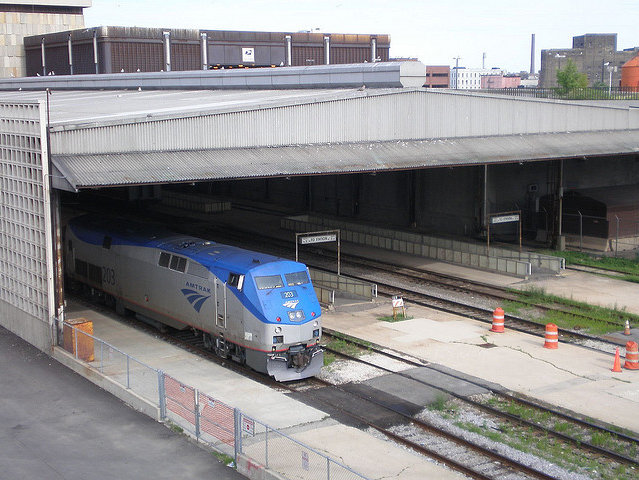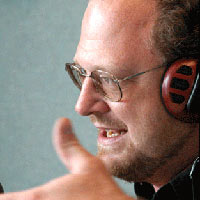The opinions expressed in this piece do not necessarily reflect the opinions of OnMilwaukee.com, its advertisers or editorial staff.
When it comes to trains, conservatives and their mouthpieces on the radio have lead the way lately in trying to derail anything to do with the future of mass transit.
If it's not opposing light rail or trolleys in the big city of Milwaukee, it's an abhorrence to high-speed links between Milwaukee, Madison, Chicago or points west.
The recent anti-rail eruption is over a plan by the feds and the state to build a new train docking area in the Downtown Intermodal Station (yeah, it needs a new name), in part to comply with disabled access and to provide a much-needed upgrade so visitors actually think they're getting off the train in a modern American city.
The feds and the state want to spend $16 million to $18 million upgrading the so-called train shed. But rail opponents continue to suggest that somehow the money can be diverted to streets and busses andanything else but trains. Sure, it is tax money, but it's not entirely local tax dollars coming out of our pockets, but spread across the entire country. And, it's dedicated money for rail and not for the concrete and asphalt that the road builders so covet.
The issue reared up at a Common Council meeting this week when Ald. Joe Dudzik wanted his colleagues to approve a resolution asking that any train station improvements wait until after a new governor takes office in January. On this issue, Dudzik has gotten in bed with the likes of GOP gubernatorial hopefuls County Exec Scott Walker, who insists that the money can be used for roads and busses, and Mark Neumann, who thinksthe money can be used for tax cuts.
Opponents to the latest train facility upgrade have glommed onto a clever title for the shed, dubbing it the "garage mahal." GOP lieutenantgovernor candidate Rebecca Kleefisch took time from her campaign for anappearance in front of the station, calling it a "garage mahal." as didDudzik.
"Seriously, you don't buy a Cadillac when you can't afford the maintenance on the Volkswagen you're driving now," says Dudzik. "We justcan't afford the boondoggle of a high speed rail system."
Dudzik pitted his views on the floor of the Common Council this week with the council's most outspoken rail advocate Bob Bauman.
Bauman notes that the train facility is 45 years old and pretty much hasoutlived its shelf life.
"The platform areas simply do not mesh at all with the renovations and upgrades at the facility that were completed within the past five years," the alderman said, referring to the millions spent in recent years making the Milwaukee train station look close to something resembling a 21st century structure (even though it has a lame name).
Bauman, the Downtown alderman, continues keen interest in the station, having been the city's leader in pointing out that the private operatorsof the public station failed to pay property taxes, ultimately forcing the state to pickup the tab for that.
The upgrade will include constructing a passenger mezzanine with elevators and escalators for boarding and disembarking trains. Special photovoltaic cells will be installed on the shed's roof to collect solarenergy, and other audio and platform improvements will also be part of the upgrade.
The station upgrades will position Milwaukee as a key stop on the Midwest high-speed rail network, contends Bauman. The federal governmentawarded Wisconsin $823 million to develop high-speed passenger rail between Milwaukee and Madison and perform improvements on the Milwaukee-Chicago line.
Bauman said the construction jobs created by the work, in addition to the economic benefits of having modern, high-speed rail in Wisconsin "can only create positive momentum and a better quality of life for our residents."
Dudzik was the sole supporter of his resolution, which was voted down 13-1.
State Sen. Tim Carpenter, who represents the southwest side of MilwaukeeCounty, also piped in on the road building fervor, suggesting that expanded freeways aren't the utopian solution. He says the proposed $1 billion expansion of Interstate 39-90 from Madison to Illinois should beused for local roads.
"It is a question of priorities. The state does not have unlimited fundsto spend on unneeded freeway expansion projects when the local roads and bridges that Wisconsin drivers use every day are in such need of repair," he said. "Prioritizing transportation fund dollars for the repair and reconstruction of our city streets would be a welcome relief for property taxpayers and for Milwaukee automobile owners paying the $20 wheel tax."
Pooches and police: Losing the family dog to a police bullet is a heart-wrenching tragedy for both sides, but inevitably, in a dispute between police, a suspect, and a dog, the dog usually loses. It will usually get a headline in the paper though.
Milwaukee's Fire and Police Commission issued its first study on police use of force on canines.
The report suggests that, of 46 use of force incidents between police and pooches in 2009, some common generalizations can be made.
Among them:
- Most of the incidents occurred in the North Sides' 15th Aldermanic District.
- Were outside and in the daylight.
- The incident stemmed from a loose dog complaint (which kind of bucks the notion that police only shoot dogs while attempting to arrest someone).
- Involved a white male police officer with an average of nine years on the force and an age of 37 years old.
- Usually involved one dog at a time whose breed is (surprise) a pit bull.
The report projects that-based on the 14 incidents in first six months of this year, the pace is that 28 incidents will happen in 2010. (The commission paid money for this mathematic conclusion.) That would be down from last year's 46 incidents and 2008's 47 shootings, it is hoped.
Of the 14 that happened so far this year:
- 11 dogs were killed, two suffered major injuries and two were unharmed. One incident had two dogs involved.
- Of the 15 dogs involved this year, 13 were pit bulls, one was a pit bull mix and one was a Doberman Pincher.
- The number of shots fired in the incidents ranged from one to 10, with the average being 3.8 rounds.
The report notes, however, that police don't just shoot dogs, they bring many strays into the Milwaukee Area Domestic Animal Control Department. In 2009, cops hauled in 625 dogs to MADAC for safe keeping.
The city regularly has to respond to legal complaints from owners of injured or killed dogs who contend police overstepped their authority on the animals. The complainants do not win. One complaint this summer was from a woman trying to collect a few hundred dollars from the city when her dog was lost for some days after police served a warrant on the occupant's of her house.
She didn't get relief.
An avid outdoors person he regularly takes extended paddling trips in the wilderness, preferring the hinterlands of northern Canada and Alaska. After a bet with a bunch of sailors, he paddled across Lake Michigan in a canoe.
He lives in Bay View.







